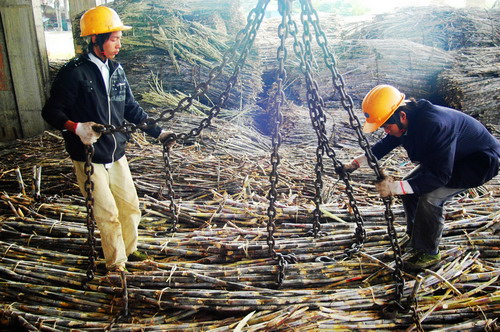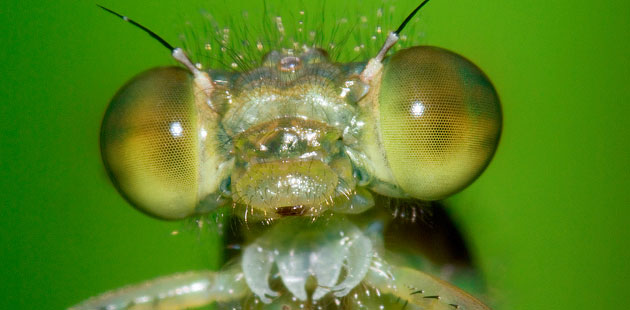The bitterest pill for the sugar industry
Updated: 2011-10-31 10:53
By Li Jiabao and Ding Qingfen (China Daily)
|
|||||||||||
|
Sugar cane ready to be crushed at a factory in Shangsi county in the Guangxi Zhuang autonomous region. China imported 520,000 tons of sugar in the first half of this year, up 27.4 percent year-on-year, according to figures from Customs. [Photo/ China Daily] |
Rising prices
The price hike of Chinese sugar is a direct result of the nation's huge level of consumption. The country's large population means that domestic output cannot always match the huge demand. And the problem has become more prominent in recent years, as a result of the rapid rise in demand.
China - the world's second-biggest sugar consumer after India - produced 11 million tons in 2010, but demand stood at between 14 million and 15 million tons between October 2009 and September 2010.
China's sugar output will reach 11.77 million tons in 2011, up 11 percent year-on-year, according to sn110.com, the largest agriculture business consultancy in Hubei province and affiliated with the National Development and Reform Commission.
However, the rising standard of living means the demand for sugar will continue to grow in the nation that consumes about one-ninth of the world's total output.
Mo predicted that the nation's annual consumption will continue to increase by between 5 and 8 percent in the coming years.
"There is great room for China to increase its sugar consumption. Annual per capita sugar consumption is about 10 kilograms (kg), much lower than the 30 kg seen in Western countries," he said.
The widening gap between supply and demand has resulted in a rise in imports. Statistics from the General Administration of Customs show that the country imported 520,000 tons of sugar in the first half of this year alone, up 27.4 percent year-on-year. In July, imports from Brazil totaled 260,000 tons and China became the biggest destination for Brazilian sugar exports that month.
Kingsman SA, a Swiss-based international sugar consultancy, said China will import 2.33 million tons of sugar this year, and that figure will increase to 2.45 million tons in 2012 because of the dry summer weather in Guangxi.
Kingsman said that China will soon overtake the European Union to become the world's biggest sugar importer, with the supplies coming mainly from Brazil, Thailand and India.
Since 2010, the government has put approximately 1.68 million tons of sugar from the national stockpile on to the market to curb surging prices.
In addition to rising costs, limited land for growing sugar cane and the low level of mechanization for collection and transportation are also making the industry a less attractive proposition.
A report from the Philosophy and Social Science Research Center of Guangxi's local government said that the area available for cultivation is 1.07 million hectares, and is highly unlikely to expand because of the hilly nature of the area.
The topography of the region also makes it difficult for farmers to mechanize the planting and collection of sugar cane, which is pushing up the costs.
In Guangxi, the cost of harvesting and collection ranges from 50 to 60 yuan a ton, accounting for one-fourth of the cost of planting sugar cane, and is six or seven times more that at mechanized farms in other producing nations, such as Brazil.
While the majority of sugar cane in Guangxi is collected manually, the amount harvested by machine in Brazil is 50 percent, and in Cuba the figure rises to 70 percent.
"The city is just a big producer of sugar cane. But our competitiveness is still quite low and we have no influence on prices or trade and circulation," said Zhao Leqin, Party secretary of Chongzuo City.
Mo, of Chongzuo Xianggui Sugar, expressed his concern about the region's sugar industry, which he said will wither as a result of higher costs coupled with limited output.
"If no measures are taken, the whole sugar industry in Guangxi will die," he said.
Diversification
Sugar producers are attempting to diversify their business by transforming sugar cane into grain-based alcohol and paper.
The Xianggui Sugar Co Ltd is one of these concerns. The waste water from its sugar production process is now used to irrigate cane fields instead of allowing it to simply drain into rivers.
Zhao said industrial transformation is the key for the industry's survival.
"We could also consider further processing of the sugar, producing goods such as candy and chocolate, to increase profits. Bagasse (the matter left after the canes are squeezed to extract the juice) could also be used for making paper dinner boxes, while the leaves and the ends of sugar canes can be processed into animal feed," said Zhao.
But the most important factor for the survival of the industry will be support through central government policies.
"Measures focusing on subsidies and prices should be implemented to encourage farmers and sugar producers to become more involved in the business," said Mo.
Huo Yan contributed to this story.
Related Stories
China to issue steady 2012 sugar import quotas 2011-09-30 16:27
Sugar stockpiles unlikely to cover shortage 2011-08-19 10:52
China's Complant buys 3 sugar plants in Jamaica 2011-08-16 15:58
China releases more reserve sugar to curb price hikes 2011-08-17 15:54
- Companies told: Want gold? Go green
- Restructure 'urgent' as population benefit ebbs
- Top financial officials changed in major reshuffle
- Small businesses seek less room to maneuver
- FAW reports $7.88m net loss in Q3
- Wrangle over auto warranty rules
- Beijing's free Wi-Fi will be safe
- It's quality not quantity for Dell










